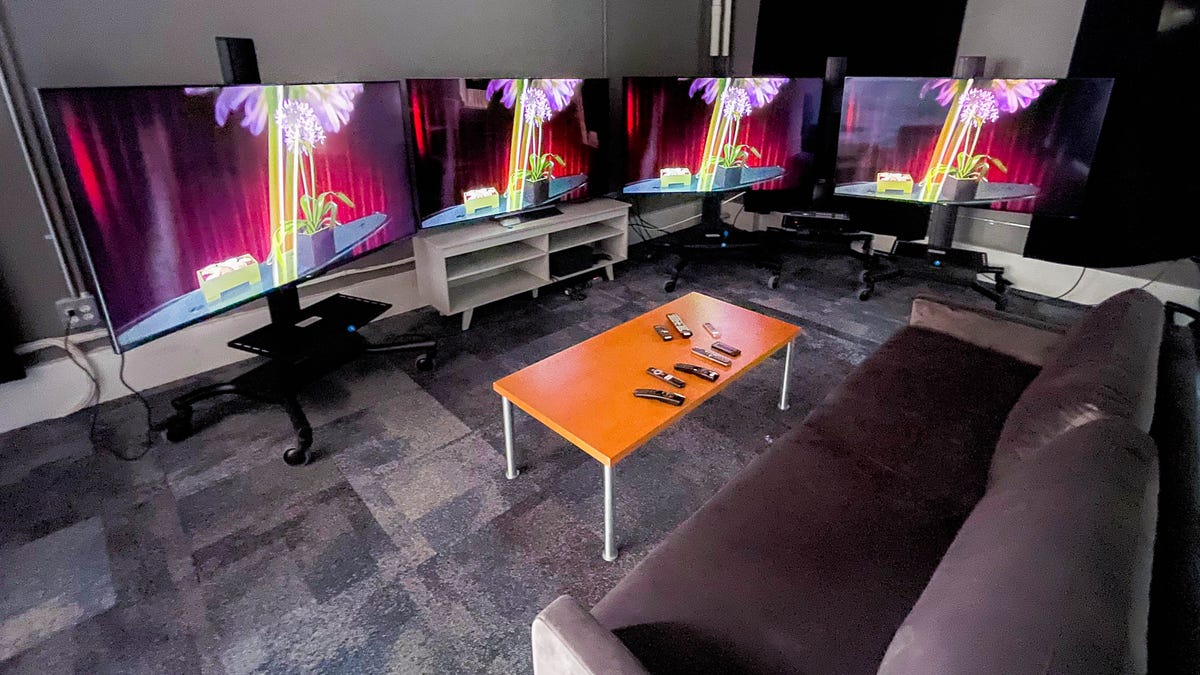Take a Tour Inside CNET's TV Test Lab
Our TV reviews use side-by-side testing and state-of-the-art equipment. Peek behind the curtain.

Welcome to CNET's TV test lab!
CNET reviewers compare big screens side-by-side in a light-controlled space using a variety of test equipment, source devices, software and a comfy couch.
Behind the curtain
Our TV lab is closed off from the rest of the product-testing space by a theatrical curtain, which allows full control of lighting within the lab.
Measurements
Inside the lab we arrange the TVs and set up a specialized meter, the Konica Minolta CS-2000 spectroradiometer (which costs about $28,000), to measure brightness, color and more.
Evaluation software
We use Portrait Displays Calman Ultimate to control the spectroradiometer and a signal generator to aid in the evaluation process. Most of the figures in the CNET's TV reviews, including color, brightness, black level, gamma and more, are derived from Calman reports.
Oh look, there's Katzmaier
CNET's head of TV reviews, David Katzmaier, has extensive experience reviewing and calibrating displays.
Going dark
Drawing the curtains allows complete darkness in the lab, which is ideal for comparing the TVs' raw picture quality, without the influence of ambient light.
Brighten up
We also test bright-room viewing conditions and look at factors such as screen brightness and reflectivity.
Full remote
We control everything with these TV remotes and remotes from a variety of source devices. And you thought your coffee table was cluttered.
Gaming tests
We play a variety of games, typically from an Xbox Series X or Sony PlayStation 5, and note the effects of gaming modes and settings as well as the 4K/120Hz and VRR input capabilities. We also measure and report input lag.
Blu-ray players and HDMI matrix
Sandwiched between two 4K UHD Blu-ray players -- a Sony UXP-700 and an Oppo BDP-203 -- is the meat of our comparison lineup, an AVPro 8x8 4K UHD Matrix Switch. The switch allows us to send any of eight sources to up to eight TVs with no signal degradation. We use Blu-ray for some of those comparisons, including reference discs like the Spears & Munsil HDR benchmark, and streaming for others.
Signal generator and 4K streamers
Our other primary sources include (from left to right) an Apple TV 4K, a Murideo 6G 4K HDR test pattern generator and a Roku Ultra. We use the streamers for TV and movie comparisons and the Murideo to supply patterns for the spectroradiometer to measure.
Cables and labels
We rely on Amazon Basics and Monoprice HDMI cables -- lots of them -- organized with the help of an Epson LW-300 label maker.
Around back
Behind the couch are a pair of nooks for meetings and storage.
Storage shelf
No lab is complete without easy access to all the extras, from cables to Blu-rays to hardware to streamers to microfiber wipes.
Ta ta for now
For more details on everything you've seen check out our full article on How we Test TVs.



